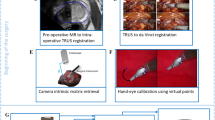Abstract
Purpose
To develop and evaluate an augmented reality instrument guidance system for MRI-guided needle placement procedures such as musculoskeletal biopsy and arthrography. Our system guides the physician to insert a needle toward a target while looking at the insertion site without requiring special headgear.
Methods
The system is comprised of a pair of stereo cameras, a projector, and a computational unit with a touch screen. All components are designed to be used within the MRI suite (Zone 4). Multi-modality fiducial markers called VisiMARKERs, detectable in both MRI and camera images, facilitate automatic registration after the initial scan. The navigation feedback is projected directly onto the intervention site allowing the interventionalist to keep their focus on the insertion site instead of a secondary monitor which is often not in front of them.
Results
We evaluated the feasibility and accuracy of this system on custom-built shoulder phantoms. Two radiologists used the system to select targets and entry points on initial MRIs of these phantoms over three sessions. They performed 80 needle insertions following the projected guidance. The system targeting error was 1.09 mm, and the overall error was 2.29 mm.
Conclusion
We demonstrated both feasibility and accuracy of this MRI navigation system. The system operated without any problems inside the MRI suite close to the MRI bore. The two radiologists were able to easily follow the guidance and place the needle close to the target without any intermediate imaging.









Similar content being viewed by others
References
Ceraulo A, Ouziel A, Lavergne E, Perrier L, Decouvelaere A-V, Chotel F, Thiesse P, Marec-Berard P (2017) Percutaneous guided biopsy for diagnosing suspected primary malignant bone tumors in pediatric patients: a safe, accurate, and cost-saving procedure. Pediatr Radiol 47(2):235–244. https://doi.org/10.1007/s00247-016-3735-3
Smith KA, Carrino J (2008) MRI-guided interventions of the musculoskeletal system. J Magn Reson Imaging Off J Int Soc Magn Reson Med 27(2):339–346. https://doi.org/10.1002/jmri.21274
Health at a Glance (2019) OECD indicators. OECD Publishing, Paris. https://doi.org/10.1787/4dd50c09-en. Accessed 31 Dec 2019
Roguin A, Goldstein J, Bar O, Goldstein JA (2013) Brain and neck tumors among physicians performing interventional procedures. Am J Cardiol 111(9):1368–1372. https://doi.org/10.1016/j.amjcard.2012.12.060
Pavic R, Margetic P, Bensic M, Brnadic RL (2013) Diagnostic value of US, MR and MR arthrography in shoulder instability. Injury 44:26–32. https://doi.org/10.1016/S0020-1383(13)70194-3
Atay E (2014) Prevalence of sport injuries among middle school children and suggestions for their prevention. J Phys Ther Sci 26(9):1455–1457. https://doi.org/10.1589/jpts.26.1455
Lim S, Sharma K, Li P, Petrisor D, Fricke S, Stoianovici D, Cleary K (2019) Robotically assisted long bone biopsy under MRI: cadaver study results. Int J Comput Assist Radiol Surg 14(1):147–156. https://doi.org/10.1007/s11548-018-1889-1
FDA MRI Safety. https://www.fda.gov/media/101221/download. Accessed 26 Jan 2023
Fritz J, U-Thainual P, Ungi T, Flammang AJ, Cho NB, Fichtinger G, Iordachita II, Carrino JA (2012) Augmented reality visualization with image overlay for MRI-guided intervention: accuracy for lumbar spinal procedures with a 1.5-T MRI system. Am J Roentgenol 198(3):266–273. https://doi.org/10.2214/AJR.11.6918
Mewes A, Heinrich F, Kägebein U, Hensen B, Wacker F, Hansen C (2019) Projector-based augmented reality system for interventional visualization inside MRI scanners. Int J Med Robot Comput Assist Surg 15(1):1950. https://doi.org/10.1002/rcs.1950
Heinrich F, Joeres F, Lawonn K, Hansen C (2019) Comparison of projective augmented reality concepts to support medical needle insertion. IEEE Trans Visual Comput Graph 25(6):2157–2167. https://doi.org/10.1109/TVCG.2019.2903942
Andress S, Johnson A, Unberath M, Winkler AF, Yu K, Fotouhi J, Weidert S, Osgood G, Navab N (2018) On-the-fly augmented reality for orthopedic surgery using a multimodal fiducial. J Med Imaging 5(2):021209–021209. https://doi.org/10.1117/1.JMI.5.2.021209
Olson E (2011) Apriltag: a robust and flexible visual fiducial system. In: 2011 IEEE international conference on robotics and automation, pp 3400–3407. https://doi.org/10.1109/ICRA.2011.5979561
Yaniv Z (2015) Which pivot calibration? In: Medical imaging 2015: image-guided procedures, robotic interventions, and modeling, vol 9415, pp 542–550. https://doi.org/10.1117/12.2081348. SPIE
Bradski G (2000) The openCV library. Dr. Dobb’s J Softw Tools Prof Program 25(11):120–123
Horn BK, Hilden HM, Negahdaripour S (1988) Closed-form solution of absolute orientation using orthonormal matrices. JOSA A 5(7):1127–1135. https://doi.org/10.1364/JOSAA.5.001127
Embodi3D. https://www.embodi3d.com. Accessed 19 Dec 2019
Kikinis R, Pieper SD, Vosburgh KG (2014) 3D slicer: a platform for subject-specific image analysis, visualization, and clinical support. In: Jolesz FA (ed) Intraoperative Imaging and Image-Guided Therapy. Springer, New York, pp 277–289. https://doi.org/10.1007/978-1-4614-7657-3_19
Crossan K, Rawson D (2022) Shoulder arthrogram. StatPearls Publishing
Funding
This work has been supported by NIH Grant Numbers 1R43EB028722-01A1 and 2R44EB028722-02A1.
Author information
Authors and Affiliations
Corresponding author
Ethics declarations
Conflict of interest
The authors declare that they have no conflict of interest.
Ethical approval
This article does not contain any studies with human participants or animals performed by any of the authors.
Informed consent
This article does not contain patient data.
Additional information
Publisher's Note
Springer Nature remains neutral with regard to jurisdictional claims in published maps and institutional affiliations.
Supplementary Information
Below is the link to the electronic supplementary material.
Supplementary file 1 (mp4 14234 KB)
Rights and permissions
Springer Nature or its licensor (e.g. a society or other partner) holds exclusive rights to this article under a publishing agreement with the author(s) or other rightsholder(s); author self-archiving of the accepted manuscript version of this article is solely governed by the terms of such publishing agreement and applicable law.
About this article
Cite this article
Foroughi, P., Demir, A., Hossbach, M. et al. In situ guidance for MRI interventions using projected feedback. Int J CARS 18, 1069–1076 (2023). https://doi.org/10.1007/s11548-023-02897-z
Received:
Accepted:
Published:
Issue Date:
DOI: https://doi.org/10.1007/s11548-023-02897-z




